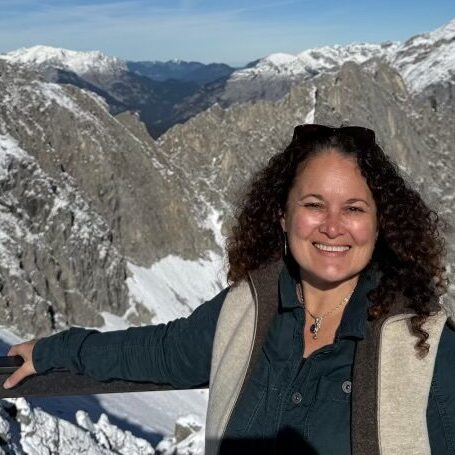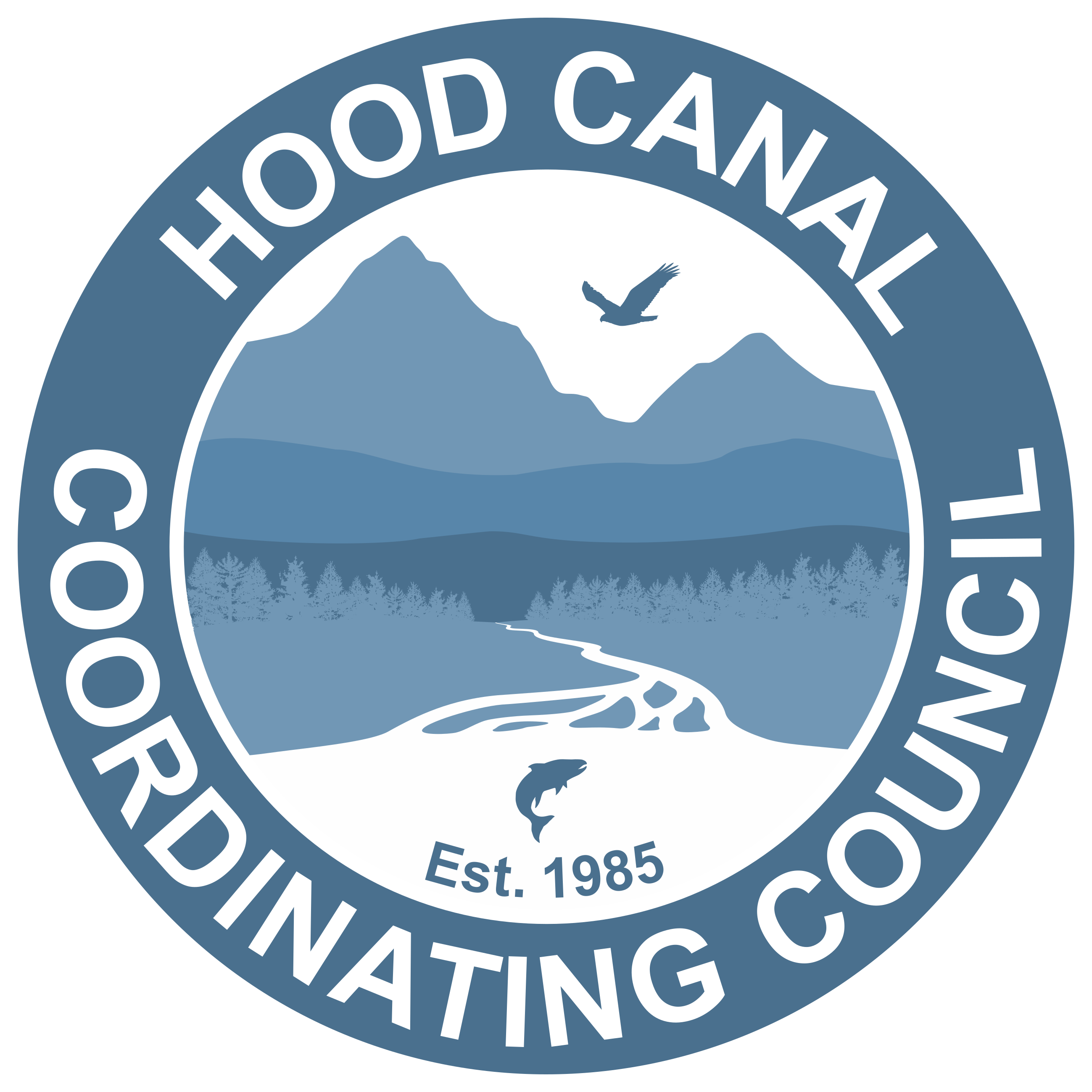Salmon Recovery Implementation
Hood Canal Coordinating Council facilitates implementation of three salmon recovery plans:
- Hood Canal and Eastern Strait of Juan de Fuca Summer Chum Salmon Recovery Plan
- Skokomish River and Mid-Hood Canal chapters of the Puget Sound Chinook Salmon Recovery Plan*
- Hood Canal Chapter of the Puget Sound Steelhead Recovery Plan*
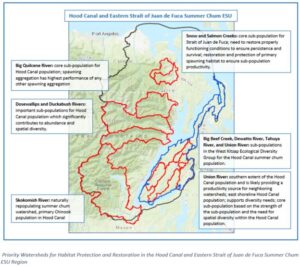 Habitat Protection & Restoration
Habitat Protection & Restoration
Summer Chum
Investments in salmon habitat protection and restoration, particularly in estuarine areas, has contributed significantly to the success of summer chum recovery across Hood Canal and the eastern Strait of Juan de Fuca. Outside of estuarine areas, additional habitat protection and restoration actions have helped address the ongoing need to strengthen performance in core summer chum spawning aggregations, bolstering overall population abundance and future resiliency, as well as ensuring properly functioning habitat that contributes to spatial diversity goals.
Chinook
The Hood Canal region is one of five bio-geographic regions needing improved habitat conditions to aid in recovery of Puget Sound Chinook Salmon. The Skokomish River is the natal watershed for two Chinook population components relevant to the recovery of this species in Hood Canal.
View Hood Canal projects funded through the WA Recreation & Conservation Office’s Salmon Recovery Funding Board
Hood Canal Lead Entity Program
HCCC’s Lead Entity (LE) Program integrates sound science with community priorities to implement key salmon recovery actions within Hood Canal and the Eastern Strait of Juan de Fuca. With support from HCCC’s Board, Salmon Program staff and partners, the LE program is uniquely equipped to aid in the implementation of summer chum recovery, delisting and a post delisting monitoring plan.
Lead Entity Process
The Lead Entity facilitates an annual process to identify, develop, review, and rank habitat protection and restoration project proposals for the Washington State Recreation and Conservation Office’s Salmon Recovery Funding Board.
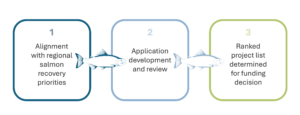
Call for Salmon Habitat Projects
Each year, HCCC issues a Call for Salmon Habitat Projects for the Lead Entity grant round that addresses specific actions and watersheds. This Call for Salmon Habitat Projects provides the basis for the selection of projects to be submitted to the Salmon Recovery Funding Board for the HCCC Lead Entity grant round.
HCCC Lead Entity Groups
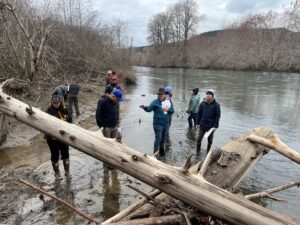
Citizens Committee – The HCCC Lead Entity Citizens Committee is made up of Citizens Advisory Group members and the HCCC Board of Directors. Citizens Committee members often are the best judges of the community’s social, cultural, and economic values. The HCCC Citizens Committee reviews and ranks salmon recovery projects on the Habitat Project List each annual grant round for submittal to the Salmon Recovery Funding Board.
Technical Advisory Group (TAG) – TAG members are professionals with specific technical expertise related to salmon habitat recovery, with a diverse skill set including, but not limited to: planning, geo-morphology, salmon and habitat biology, ecology, engineering and other scientific concentrations. They evaluate projects on their technical merits, benefits to salmon, and the certainty that the benefits will occur. The technical committee submits its evaluations of projects to the Citizens Committee.
Citizens Advisory Group (CAG) – CAG members are citizens from the surrounding communities of the Hood Canal with an interest in salmon habitat recovery projects. Membership consists of representative interests from: geographic sub-regions of Hood Canal, tribes, environmental groups, habitat interest groups, regional fish enhancement groups, conservation districts, business groups, volunteer groups, landowners, and citizens.
Salmon Recovery Funding Board
Members of the Salmon Recovery Funding Board are appointed by the Governor to administer federal and state funding for salmon recovery. The board reviews all projects for eligibility, and the technical review panel evaluates each project for technical merits, certainty of success, and to ensure there are benefits to salmon.
Watershed Salmon Forums
The Hood Canal Coordinating Council is conducting a status of threats assessment on the Snow Creek & Salmon Creek spawning aggregation of Hood Canal & eastern Strait of Juan de Fuca summer chum. The Salmon-Snow spawning aggregation is the most productive subpopulation within the Eastern Strait summer chum population. HCCC, Co-Managers, and partners met to consider needs for a collaborative development of an integrated vision for the Salmon-Snow Creek watershed and Discovery Bay that encompasses long-term goals for summer chum salmon recovery, steelhead recovery, scientific monitoring, a healthy coho population, other native aquatic species, while addressing vulnerabilities to infrastructure in the watershed and interests of property owners. Building off the Forum discussions, HCCC headed up a study to better understand current conditions and potential options to inform an integrated strategy in the future. This effort resulted in the following reports:
- Lower Snow and Salmon Creeks and Estuary Integrated Restoration Strategy: Alternatives for continuation of the comprehensive salmon and steelhead monitoring program
- Lower Snow and Salmon Creeks and Estuary Integrated Strategy: Strategic reconnection assessment and estuary restoration and highway corridor improvement considerations
The HCCC status of threats assessment on the Quilcene spawning aggregation of Hood Canal summer chum will be used to update the Hood Canal and Eastern Strait of Juan de Fuca Summer Chum Recovery Plan. The Quilcene sub-population is the most productive sub-population within the Hood Canal summer chum population, as well as within the entire summer chum Evolutionarily Significant Unit (ESU). Therefore, it is very important that it is both protected and strengthened to ensure its continued strong performance as pressures from future land use and climate change increase. HCCC convened a Quilcene Summer Chum Forum to discuss what is working well for the spawning aggregation and what may not be; what restoration actions are currently underway; and what may still need to be considered to increase resiliency.
The Skokomish Watershed Action Team (SWAT) is a broad-based, informal collaborative group formed in 2005 dedicated to restoring the Skokomish River watershed. The SWAT typically holds semi-annual meetings, as well as occasional field trips to view and discuss restoration needs and activities in the Skokomish watershed. In addition, a Steering Committee holds monthly conference calls, and SWAT coordinators distribute updates to the SWAT email list.
- View the Skokomish Watershed Action Plan in the Library
- SWAT meeting information is available in the Calendar
- An archive of past SWAT documents (pre-2022) is available here
- Contact Haley Harguth or Alicia Olivas to join the SWAT mailing list
The Chumsortium is an assemblage of agencies, groups and partners who are dedicated to taking actions that will recover wild salmon in East Jefferson County. Chumsortium began in 2001 with a focus on Chimacum Creek but has expanded geographically to include all of the watersheds and marine shorelines of East Jefferson County. The group’s main function is to improve coordination and partnering for project development, funding, and implementation.
The Chumsortium is comprised of the following groups, among others:
- Hood Canal Coordinating Council
- Hood Canal Salmon Enhancement Group
- Jamestown S’Klallam Tribe
- Jefferson County
- Jefferson County Extension WA State University
- Jefferson County Conservation District
- Jefferson County Marine Resources Committee
- Jefferson Land Trust
- North Olympic Peninsula Lead Entity
- North Olympic Salmon Coalition (Chumsortium Coordinator)
- Port Gamble S’Klallam Tribe
- Puget Sound Partnership
- WA Dept of Fish and Wildlife
- WA Dept of Natural Resources – Natural Area Program
Events
Library
